Top Crypto Trading Platforms in 2025







%201.svg)
%201.svg)
Big news: We’re cranking up the heat on AI-driven crypto analytics with the launch of the Token Metrics API and our official SDK (Software Development Kit). This isn’t just an upgrade – it's a quantum leap, giving traders, hedge funds, developers, and institutions direct access to cutting-edge market intelligence, trading signals, and predictive analytics.
Crypto markets move fast, and having real-time, AI-powered insights can be the difference between catching the next big trend or getting left behind. Until now, traders and quants have been wrestling with scattered data, delayed reporting, and a lack of truly predictive analytics. Not anymore.
The Token Metrics API delivers 32+ high-performance endpoints packed with powerful AI-driven insights right into your lap, including:
Getting started with the Token Metrics API is simple:
At Token Metrics, we believe data should be decentralized, predictive, and actionable.
The Token Metrics API & SDK bring next-gen AI-powered crypto intelligence to anyone looking to trade smarter, build better, and stay ahead of the curve. With our official SDK, developers can plug these insights into their own trading bots, dashboards, and research tools – no need to reinvent the wheel.
%201.svg)
%201.svg)
Understanding how to efficiently manage exposure in the dynamic world of cryptocurrency can seem daunting. Crypto indices provide a structured approach, helping investors and traders maintain diversified exposure without constant oversight. This article explores what crypto indices are, how they work, and why their rebalancing strategies are crucial in 2025.
A crypto index is a rules-based basket of digital assets that tracks a specific set of cryptocurrencies, such as the top-100 by market capitalization. These indices are designed to reflect broad market trends while reducing the complexity of individual asset management. They typically rebalance periodically to maintain consistent exposure, adapting to market fluctuations over time.
The core mechanism involves a few key processes:
Crypto indices offer several advantages:
Investors interested in accessing crypto indices can follow a straightforward process:
Crypto indices may suit different kinds of investors:
Understanding your trading style and risk appetite can help determine if a crypto index fits within your broader strategy.
Discover Crypto Gems with Token Metrics AI
A crypto index is a rules-based basket that tracks a defined set of assets (e.g., the top-100 by market cap), with a scheduled rebalance to keep exposure aligned. Token Metrics applies that idea and adds a regime switch to stablecoins.
Weekly. Constituents and weights update on schedule; if the market regime changes, the portfolio can switch between tokens and stablecoins outside that cadence.
A proprietary market signal. Bullish: hold the top-100 basket. Bearish: exit to stablecoins and wait for a re-entry signal.
At launch, funding options including wallet-funding supported by the embedded smart wallet and supported chains; USDC payouts are available when selling. Details are available during the buy/sell process.
No. The embedded wallet is self-custodial—you control your funds and keys.
Before confirming, you'll see estimated gas costs, platform fees, max slippage, and minimum expected value.
Visit the Token Metrics indices hub, open TM Global 100, and tap “Join Waitlist.” We will notify you once trading opens.
Self-custody: Embedded smart wallet with user-controlled keys. Transparency: Clear rules, holdings Treemap, and transactions logs. Fees: Shown before confirmation. Limitations: Signals can be wrong, no performance guarantees. Availability may vary by region and device.
Crypto is volatile and can lose value. Past performance does not predict future results. This article is for research and educational purposes only, not financial advice.
%201.svg)
%201.svg)
If you’ve ever wished for a crypto index that participates broadly in bull markets yet steps aside when risk turns south, this is it. Token Metrics Global 100 is a rules-based index that holds the top 100 crypto assets when our market signal is bullish—and moves fully to stablecoins when it isn’t. It rebalances weekly, shows transparent holdings and transaction logs, and can be purchased in one click with an embedded wallet. That’s disciplined exposure, minus the micromanagement. → Join the waitlist to be first to trade TM Global 100.
Two things define this cycle: speed and uncertainty. Narratives rotate in weeks, not months, and individual-coin risk can swamp portfolios. Indices let you own the market when conditions warrant, while a regime-switching approach aims to sidestep drawdowns by cutting risk to stablecoins. (A crypto index is a rules-based basket tracking a defined universe—here, a top-100 market-cap set—with scheduled rebalances.)
Regime switching: Bull: hold the top 100 by market cap. Bear: move fully to stablecoins, wait for a bullish re-entry signal.
Weekly rebalancing: Updates weights and constituents to reflect the current top-100 list.
Transparency: A Strategy modal explains rules; a Gauge shows the live market signal; Holdings appear in Treemap + Table; and every rebalance/transaction is logged.
What you’ll see on launch: Price tile • “100 tokens” • “rebalances weekly” • one-click Buy Index flow. → See the strategy and rules. (TM Global 100 strategy)
Time back: No more tracking 100 tickers or manual reweights. The weekly job runs for you.
Discipline on drawdowns: The stablecoin switch enforces risk management when the signal turns.
Less execution drag: One embedded wallet checkout vs. dozens of small trades that add slippage and fees.
See everything: Gauge → Treemap → Transactions Log—know what you hold, and what changed.
Own the market when it’s worth it: Capture broad upside in bullish regimes with top-100 breadth.
Open the Token Metrics Indices hub.
Tap TM Global 100 and select Join Waitlist.
(Optional) Connect wallet to preview the one-click Buy flow and funding options.
On launch, you’ll receive an email and in-app prompt.
Click Buy Index → review fees/slippage/holdings → confirm. Most users finish in ~90 seconds.
Track your position under My Indices with real-time P&L and a full transactions history. → Join the waitlist to be first to trade TM Global 100.
A rules-based basket that tracks a defined universe (here: top-100 market cap), with scheduled rebalances and clear inclusion criteria.
Weekly, with additional full-portfolio switches when the market regime changes.
A proprietary market signal. Bullish: hold top-100. Bearish: move fully to stablecoins until re-entry.
You’ll use the embedded wallet and supported on-chain assets; USDC is supported for selling. Funding options surface based on chain/wallet at checkout.
No. It’s an embedded, self-custodial smart wallet—you control funds.
At checkout, you’ll see estimated gas, platform fee, max slippage, and minimum expected value before confirming.
Visit the Indices hub, open TM Global 100, and tap Join Waitlist; we’ll notify you at launch.
Self-custody: Embedded smart wallet; you hold keys.
Operational clarity: Strategy modal, Holdings treemap/table, and Transactions log.
Fee & slippage preview: All shown before you confirm.
Regime logic limits: Signals can be wrong; switching can incur spreads and gas.
Region notes: Chain and asset support may vary by user wallet and jurisdiction.
Crypto is volatile and can lose value. Past performance is not indicative of future results. This article is for research/education, not financial advice.
If you want broad upside when it’s worth it and stablecoins when it’s not—with weekly rebalances, transparent logs, and a 90-second buy flow—Token Metrics Global 100 was built for you. Join the waitlist now and be first to trade at launch.
%201.svg)
%201.svg)
The cryptocurrency market has evolved from a niche digital experiment into a multi-trillion-dollar asset class. With thousands of tokens and coins available across hundreds of exchanges, the question isn't whether you should research before buying—it's how to conduct that research effectively. Smart investors know that thorough due diligence is the difference between identifying the next promising project and falling victim to a costly mistake.
Before diving into specific research methods, successful crypto investors start by understanding the fundamental difference between various digital assets. Bitcoin operates as digital gold and a store of value, while Ethereum functions as a programmable blockchain platform. Other tokens serve specific purposes within their ecosystems—governance rights, utility functions, or revenue-sharing mechanisms.
The first step in any research process involves reading the project's whitepaper. This technical document outlines the problem the project aims to solve, its proposed solution, tokenomics, and roadmap. While whitepapers can be dense, they reveal whether a project has substance or merely hype. Pay attention to whether the team clearly articulates a real-world problem and presents a viable solution.
A cryptocurrency project is only as strong as the team behind it. Investors scrutinize founder backgrounds, checking their LinkedIn profiles, previous projects, and industry reputation. Have they built successful companies before? Do they have relevant technical expertise? Anonymous teams aren't automatically red flags, but they require extra scrutiny and compelling reasons for their anonymity.
Development activity serves as a crucial health indicator for any blockchain project. GitHub repositories reveal whether developers are actively working on the project or if it's effectively abandoned. Regular commits, open issues being addressed, and community contributions all signal a vibrant, evolving project. Conversely, repositories with no activity for months suggest a project that may be dying or was never serious to begin with.
Understanding a token's economic model is essential for predicting its long-term value potential. Investors examine total supply, circulating supply, and emission schedules. Is the token inflationary or deflationary? How many tokens do the team and early investors hold, and when do those tokens unlock? Large unlock events can trigger significant price drops as insiders sell.
The token's utility within its ecosystem matters tremendously. Does holding the token provide governance rights, staking rewards, or access to platform features? Tokens without clear utility often struggle to maintain value over time. Smart researchers also investigate how value accrues to token holders—whether through buybacks, burning mechanisms, or revenue sharing.
Price action tells only part of the story, but market metrics provide valuable context. Trading volume indicates liquidity—can you buy or sell significant amounts without drastically moving the price? Market capitalization helps determine a token's relative size and potential growth runway. A small-cap project has more room to grow but carries higher risk.
On-chain metrics offer deeper insights into token health. Active addresses, transaction volume, and network usage reveal actual adoption versus speculation. High trading volume on exchanges with minimal on-chain activity might indicate wash trading or manipulation. Token distribution matters too—if a small number of wallets hold most of the supply, the token faces centralization risks and potential price manipulation.
Professional crypto investors increasingly rely on sophisticated analytics platforms that aggregate multiple data sources and provide actionable insights. Token Metrics has emerged as a leading crypto trading and analytics platform, offering comprehensive research tools that save investors countless hours of manual analysis.
Token Metrics combines artificial intelligence with expert analysis to provide ratings and predictions across thousands of cryptocurrencies. The platform evaluates projects across multiple dimensions—technology, team, market metrics, and risk factors—delivering clear scores that help investors quickly identify promising opportunities. Rather than manually tracking dozens of metrics across multiple websites, users access consolidated dashboards that present the information that matters most.
The platform's AI-driven approach analyzes historical patterns and current trends to generate price predictions and trading signals. For investors overwhelmed by the complexity of crypto research, Token Metrics serves as an invaluable decision-support system, translating raw data into understandable recommendations. The platform covers everything from established cryptocurrencies to emerging DeFi tokens and NFT projects, making it a one-stop solution for comprehensive market research.
Cryptocurrency projects thrive or die based on their communities. Active, engaged communities signal genuine interest and adoption, while astroturfed communities relying on bots and paid shillers raise red flags. Investors monitor project Discord servers, Telegram channels, and Twitter activity to gauge community health.
Social sentiment analysis has become increasingly sophisticated, with tools tracking mentions, sentiment polarity, and influencer engagement across platforms. Sudden spikes in social volume might indicate organic excitement about a partnership or product launch—or orchestrated pump-and-dump schemes. Experienced researchers distinguish between authentic enthusiasm and manufactured hype.
The regulatory landscape significantly impacts cryptocurrency projects. Researchers investigate whether projects have faced regulatory scrutiny, registered as securities, or implemented compliance measures. Geographic restrictions, potential legal challenges, and regulatory clarity all affect long-term viability.
Security audits from reputable firms like CertiK, Trail of Bits, or ConsenSys Diligence provide crucial assurance about smart contract safety. Unaudited contracts carry significant risk of exploits and bugs. Researchers also examine a project's history—has it been hacked before? How did the team respond to security incidents?
Experienced investors develop instincts for spotting problematic projects. Guaranteed returns and promises of unrealistic gains are immediate red flags. Legitimate projects acknowledge risk and market volatility rather than making impossible promises. Copied whitepapers, stolen team photos, or vague technical descriptions suggest scams.
Pressure tactics like "limited time offers" or artificial scarcity designed to force quick decisions without research are classic manipulation techniques. Projects with more focus on marketing than product development, especially those heavily promoted by influencers being paid to shill, warrant extreme skepticism.
Cryptocurrency research isn't a one-time activity but an ongoing process. Markets evolve rapidly, projects pivot, teams change, and new competitors emerge. Successful investors establish systems for monitoring their holdings and staying updated on developments. Setting up Google Alerts, following project social channels, and regularly reviewing analytics help maintain awareness of changing conditions.
Whether you're evaluating established cryptocurrencies or exploring emerging altcoins, thorough research remains your best defense against losses and your greatest tool for identifying opportunities. The time invested in understanding what you're buying pays dividends through better decision-making and improved portfolio performance in this dynamic, high-stakes market.
.png)
%201.svg)
%201.svg)
ETF funds, or Exchange-Traded Funds, have revolutionized investing for both retail and institutional investors. In 2025, ETF funds are more popular than ever—offering a simple, low-cost, and diversified way to invest in everything from tech stocks to cryptocurrencies. But what exactly is an ETF fund, and why is it such a powerful investment tool?
In this article, we’ll explain:
Let’s dive in.
An ETF fund (Exchange-Traded Fund) is a type of investment fund that holds a basket of securities—such as stocks, bonds, commodities, or cryptocurrencies—and is traded on a stock exchange, just like individual stocks.
When you buy a share of an ETF fund, you are buying partial ownership of that entire portfolio of assets. This gives you instant diversification without having to purchase each asset individually.
For example, an ETF fund that tracks the S&P 500 allows you to invest in 500 of the largest U.S. companies with just one purchase.
ETF funds are created by financial institutions called fund sponsors (like BlackRock, Fidelity, or Vanguard). These sponsors select and manage a portfolio of underlying assets and list the ETF shares on stock exchanges.
Here's how it works:
ETF prices are influenced by a combination of Net Asset Value (NAV) and real-time market supply/demand.
In 2025, investors have access to a wide variety of ETF funds based on asset classes, strategies, and markets.
Track specific sectors (e.g., tech, healthcare), regions (e.g., U.S., Europe), or indices (e.g., S&P 500, NASDAQ-100).
Provide exposure to government, municipal, or corporate bonds with varying durations and yields.
Track physical commodities like gold, silver, oil, or agricultural products.
Focus on emerging trends or industries like artificial intelligence, clean energy, space exploration, or blockchain.
Give exposure to digital assets such as Bitcoin, Ethereum, and DeFi tokens—without requiring direct crypto ownership.
In 2025, crypto ETF funds are among the fastest-growing segments in the market. They offer secure, regulated access to cryptocurrencies via traditional brokerages.
Crypto ETFs include:
These ETFs have made it easier for both institutions and retail investors to gain exposure to crypto without managing wallets, keys, or exchanges.
ETF funds offer several advantages for investors in 2025:
With just one purchase, you gain exposure to a broad portfolio of assets—reducing risk.
ETFs trade on exchanges all day, allowing you to buy or sell quickly at market prices.
Most ETFs have expense ratios under 0.20%, much lower than actively managed mutual funds.
Most ETF funds disclose their holdings daily, so you always know what you’re investing in.
Due to their structure, ETFs are generally more tax-efficient than mutual funds.
Like all investments, ETF funds come with risks:
If the market or sector an ETF tracks declines, your investment will also lose value.
Some ETFs, especially niche or low-volume ones, can have wider spreads and lower liquidity.
An ETF may not perfectly track the performance of its underlying index due to fees, slippage, or poor replication.
Some thematic ETFs may be overly concentrated in a few assets, increasing volatility.
Token Metrics is an AI-powered crypto analytics and trading platform that helps investors research, evaluate, and make smarter decisions—including with crypto ETFs.
Here’s how Token Metrics helps you get ahead:
Token Metrics uses advanced AI models to assign Investor Grades and Trader Grades to crypto assets, helping you identify the strongest performers—often held by top ETFs.

Get forward-looking price predictions on Bitcoin, Ethereum, and other assets held in ETFs—so you can assess whether an ETF is likely to appreciate.

Token Metrics tracks real-time ETF inflows, exchange reserves, and on-chain data, giving you insight into supply-demand dynamics that move prices.

Set alerts for key changes in asset ratings, prices, or bullish/bearish signals to stay informed on ETF-related opportunities.

By combining ETF investing with Token Metrics insights, you position yourself ahead of market trends and optimize your portfolio performance.
Here are some high-performing ETF funds in traditional and crypto markets:
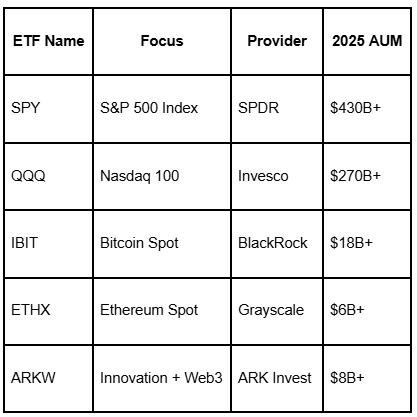
🧠 Final Thoughts
ETF funds are one of the most efficient and flexible ways to build a diversified investment portfolio in 2025. Whether you're targeting long-term growth, passive income, or exposure to emerging markets like crypto—ETF funds offer a secure, low-cost, and easy-to-use investment solution.
And with the rise of crypto ETF funds, platforms like Token Metrics are critical in helping investors evaluate opportunities, manage risk, and time the market using AI.
Whether you're a seasoned investor or just getting started, combining ETF investing with AI-powered insights gives you the edge in today's rapidly evolving financial landscape.
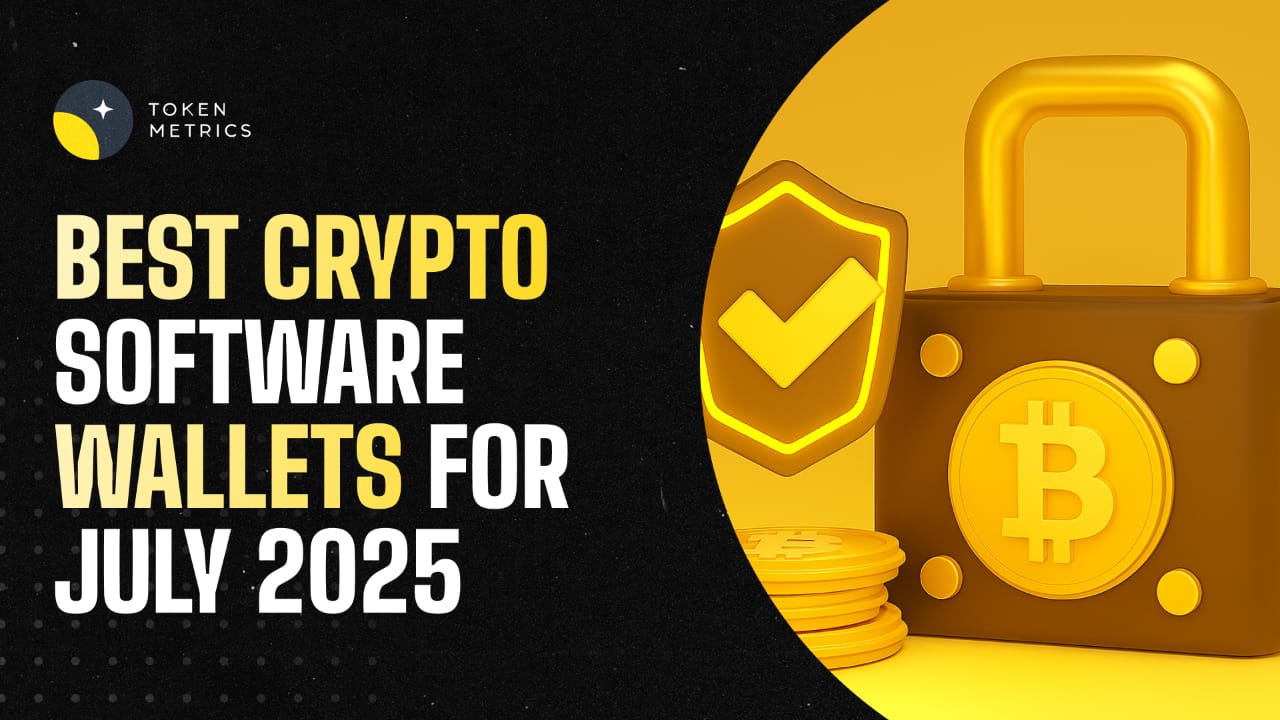
%201.svg)
%201.svg)
And How Token Metrics Lets You Trade Securely With Any Wallet
Cryptocurrency adoption continues to rise in 2025, and with it, the demand for secure, user-friendly, and feature-rich crypto software wallets. Whether you're storing Bitcoin, trading Ethereum, or experimenting with altcoins, having a reliable wallet is the foundation of safe crypto ownership.
This guide ranks the top crypto software wallets of July 2025 across different categories, from best security to best for mobile use. We also explore how Token Metrics, the leading AI crypto trading platform, allows users to connect any of these wallets via an encrypted channel—giving you access to powerful AI-driven tools while retaining full custody of your assets.

A crypto software wallet is a digital application that stores your private keys and enables you to send, receive, and manage cryptocurrencies. These wallets can be hot (internet-connected) or cold (offline) and often come with trading, staking, and asset management tools. The best wallets balance security, usability, and functionality—and increasingly, they integrate with platforms like Token Metrics to enable AI-powered trading without giving up control of your assets.

Zengo tops the list for users prioritizing wallet security. With no reported wallet hacks and weekly software updates, Zengo protects over 1.5 million users globally. It also supports buying, selling, and staking, making it ideal for long-term holders.
Pros:
✔️ Industry-leading security measures
✔️ Staking and fiat funding options
✔️ Encrypted backup and biometric authentication
Cons:
❌ Premium pricing
❌ No hardware wallet compatibility

Coinbase Wallet is perfect for newcomers. It’s intuitive, completely free to use, and connects seamlessly to the larger Coinbase ecosystem. Users can access over 5,500 tokens and learn the ropes through its built-in educational resources.
Pros:
✔️ Beginner-friendly UI
✔️ Massive token support
✔️ Customizable network fees
Cons:
❌ Code not open source
❌ No address rotation
❌ Doesn’t fully support hardware wallets
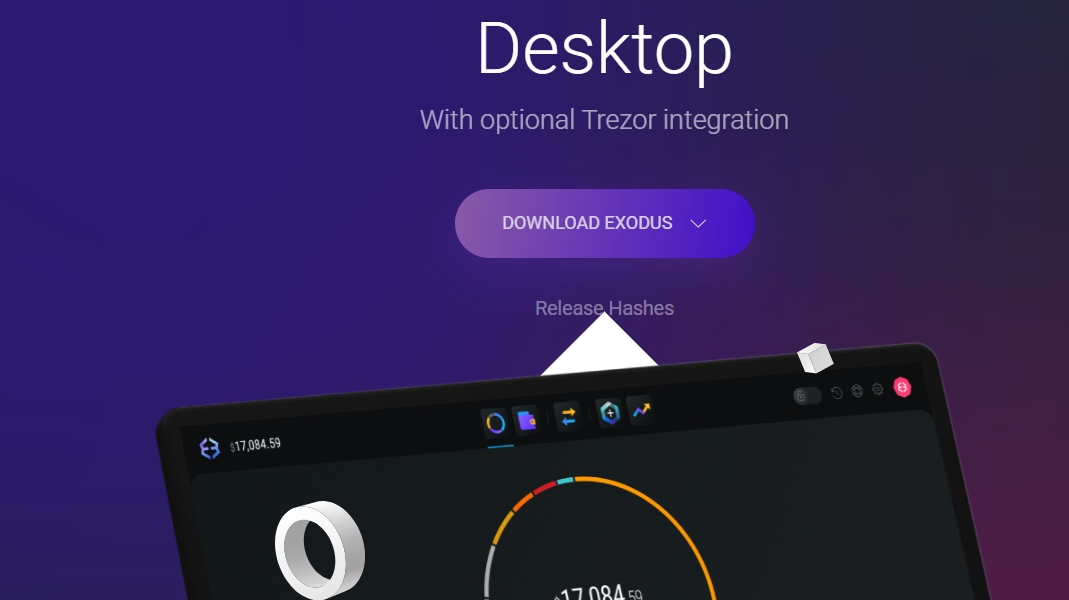
Exodus excels on mobile with sleek design and robust functionality. It allows users to buy, sell, stake, and swap directly on their mobile device and integrates with Trezor hardware wallets for additional security.
Pros:
✔️ Cross-platform (desktop, browser, mobile)
✔️ Built-in portfolio tracking
✔️ Trezor integration
Cons:
❌ No in-house exchange
❌ Email-only support
❌ Not open source
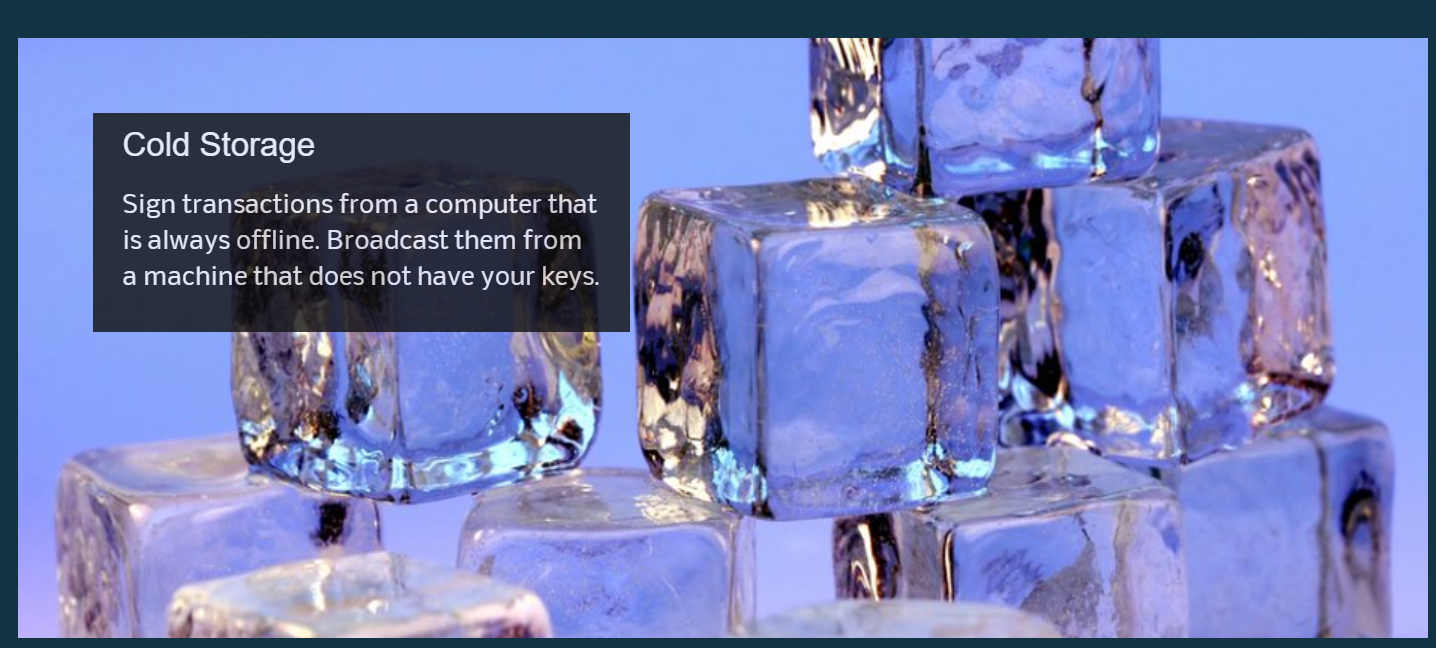
A trusted wallet since Bitcoin’s early days, Electrum is ideal for Bitcoin maximalists. It’s lightweight, fast, and secure, with deep customization options for advanced users.
Pros:
✔️ High performance for BTC
✔️ Cold storage compatible
✔️ Open-source and auditable
Cons:
❌ No support for altcoins
❌ Not user-friendly for beginners
❌ No staking or DeFi features

For Ethereum users, MetaMask is the go-to wallet. It enables DeFi, NFTs, and Web3 access with ease. It supports both hot and cold storage and integrates with platforms like OpenSea, Uniswap, and now, Token Metrics.
Pros:
✔️ Built for Ethereum ecosystem
✔️ DeFi-ready
✔️ Cold wallet compatible
Cons:
❌ No Bitcoin support
❌ Limited customer support
❌ Doesn’t rotate addresses automatically
Token Metrics is not a wallet, exchange, or custodian—it’s an AI-driven crypto research and trading platform. But it seamlessly integrates with your preferred wallet using secure, encrypted wallet connections.

Token Metrics allows users to connect wallets like MetaMask, Coinbase Wallet, Trust Wallet, or any Web3-compatible wallet using industry-standard encryption. You never deposit funds on the platform—instead, you retain full control over your crypto while accessing:

With so many platforms requiring you to deposit crypto into centralized accounts, Token Metrics stands apart by offering non-custodial AI-powered trading. You keep your assets in your chosen wallet while using advanced tools that would normally be reserved for hedge funds or trading desks.
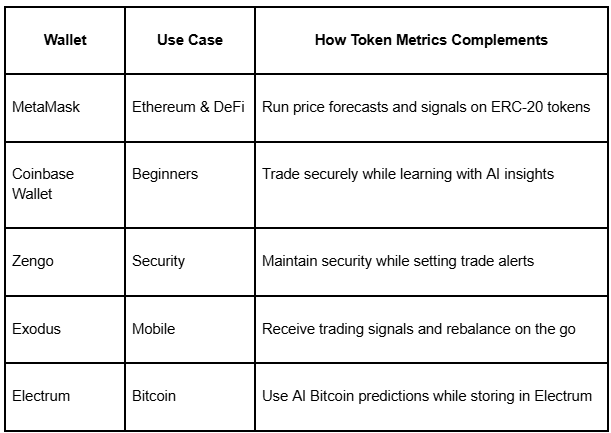
Crypto is a volatile and speculative market. Even with the best wallet and the most advanced AI platform, there are risks. Always use two-factor authentication, avoid phishing attempts, and never share your seed phrase.
Choosing the best crypto software wallet in July 2025 depends on your priorities: security, mobility, beginner-friendliness, or asset specialization. But if you want to take things further, pairing your wallet with Token Metrics’ AI research and trading tools is the smartest way to stay ahead.
Whether you’re holding Bitcoin in Electrum or swapping altcoins via MetaMask, Token Metrics helps you trade smarter, not harder, without compromising the safety of your assets.
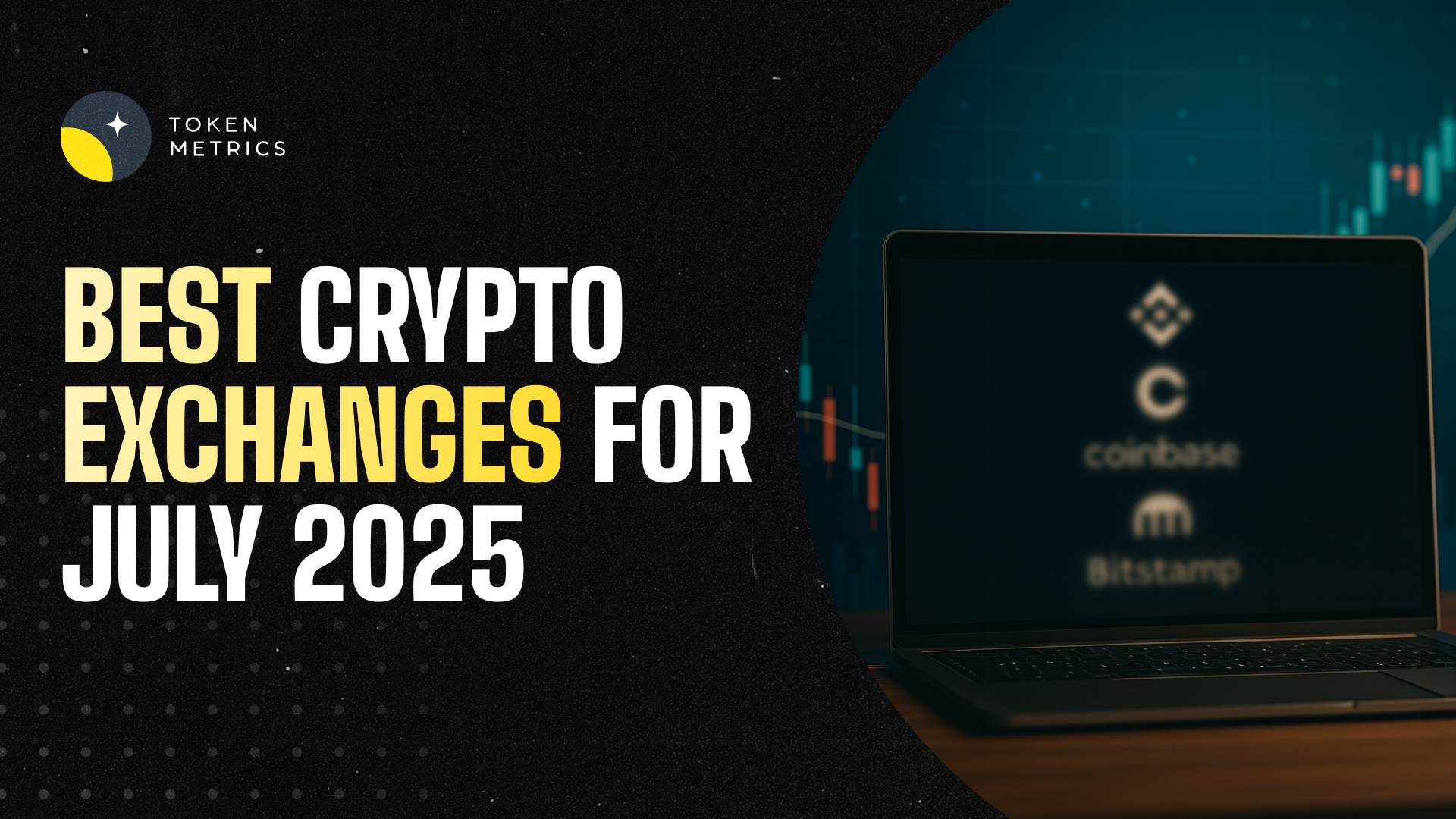
%201.svg)
%201.svg)
Cryptocurrency adoption has surged in 2025, with Bitcoin reaching over $118,000 and Ethereum climbing above $3,000. Whether you’re a beginner or an advanced trader, choosing the right exchange or trading app is critical. But while exchanges handle your transactions, it’s tools like Token Metrics that give you the edge—using AI to deliver real-time analytics, trading signals, moonshot altcoin picks, and price predictions.
In this guide, we’ll cover the top exchanges and apps for July 2025, along with Token Metrics, the best platform for AI-powered crypto research and trading.
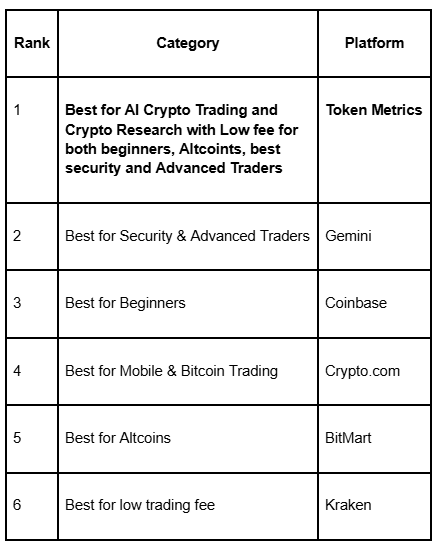
Token Metrics stands out not as an exchange, but as an AI-powered research, analytics, and trading platform. It gives retail and institutional investors data-driven insights to make smarter trades across any exchange.






Whether you’re trading on Kraken, Coinbase, or Binance, Token Metrics plugs into your strategy and helps you trade with confidence, using real-time AI insights.

Kraken is ideal for fee-sensitive traders. It’s available on web, mobile, desktop, and Kraken Pro. However, it's not available in all U.S. states and lacks FDIC or SIPC insurance.

Gemini is the most secure exchange in 2025, with FDIC insurance, crypto insurance, and advanced features through its ActiveTrader terminal. But it has a complex fee structure and limited assets.
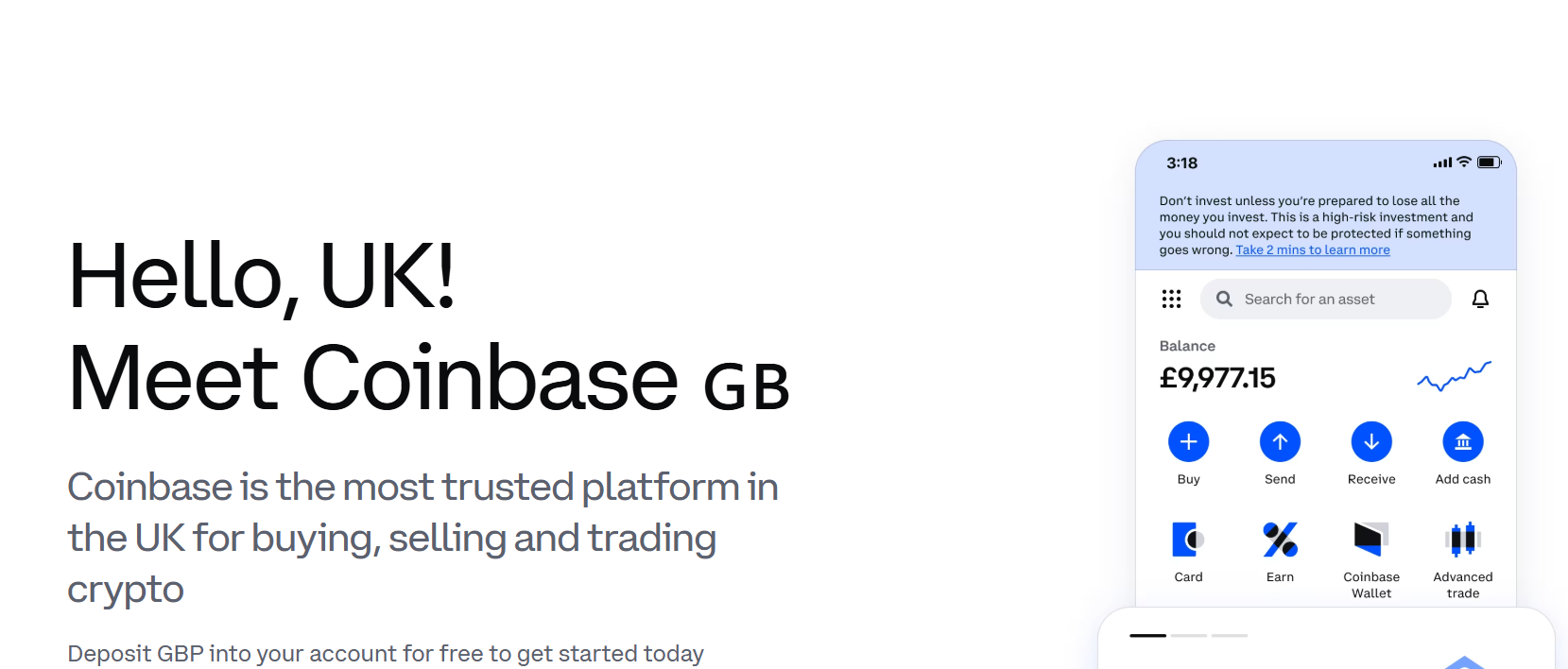
Coinbase is ideal for newcomers with its clean UI, beginner-friendly tools, and educational content. It’s available in 172 countries, though advanced traders might want more features.
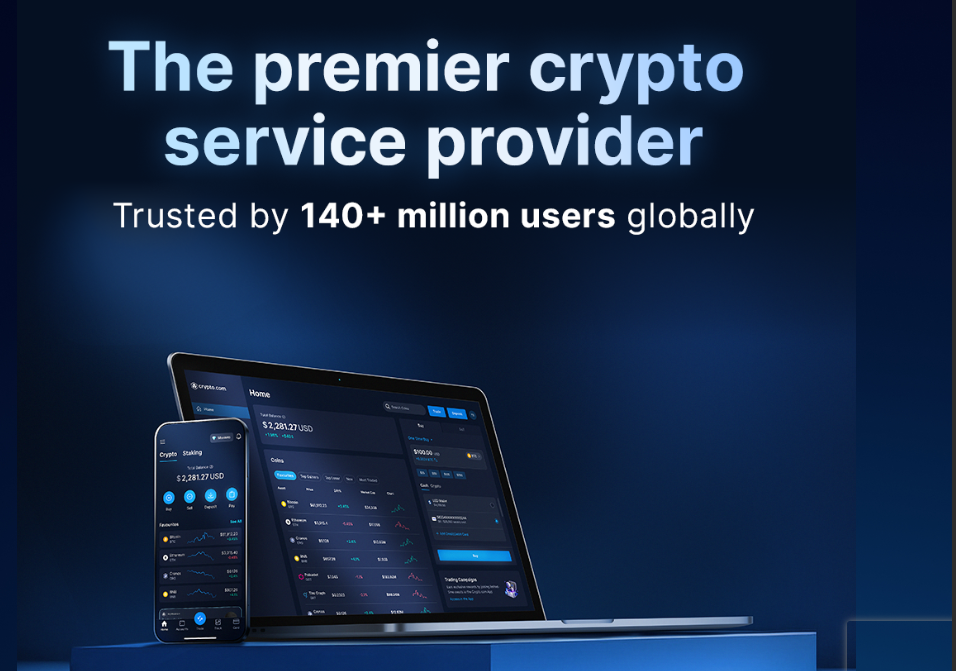
With a sleek mobile app and support for Bitcoin options and futures, Crypto.com is perfect for on-the-go traders. However, it only supports a hot wallet and has limited global access.
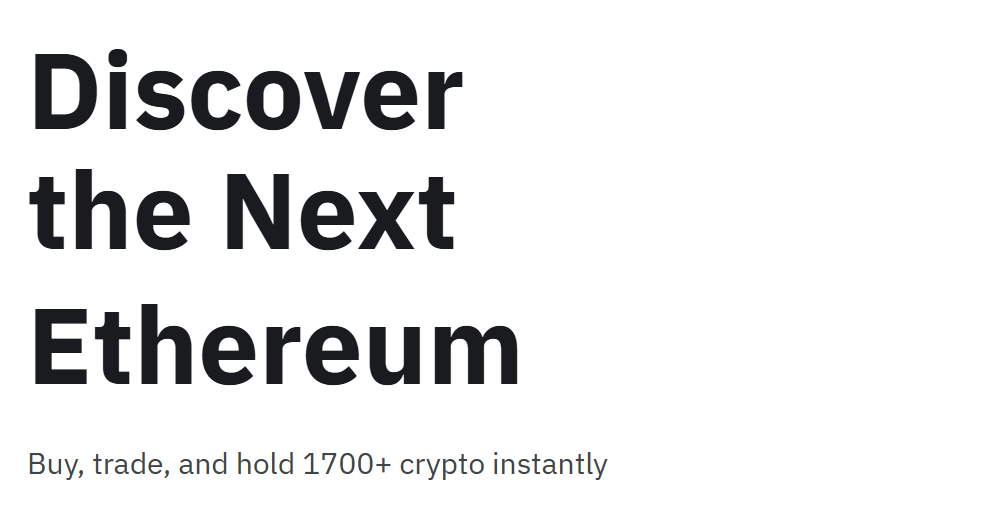
BitMart is the best place to find rare altcoins. With copy trading and BitMart Academy, it’s useful for altcoin hunters. But its lack of transparency on security is a concern.
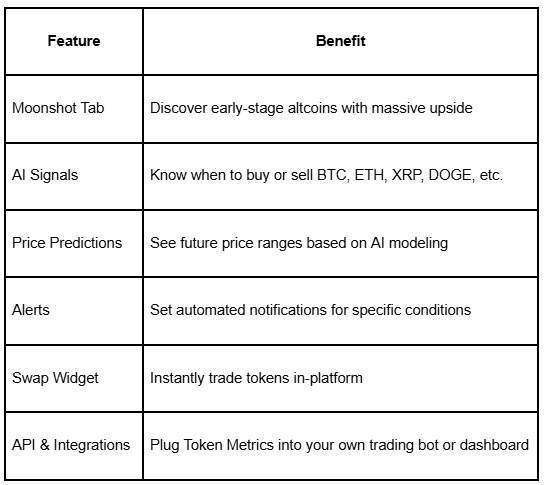
Crypto markets are volatile and speculative. While these exchanges and tools can improve your strategy, always do your own research (DYOR) and consult professionals when investing.
If you want to trade crypto in July 2025, pair a high-quality exchange like Kraken or Coinbase with a research powerhouse like Token Metrics. Exchanges execute trades—but Token Metrics tells you what to trade, when to trade, and why.
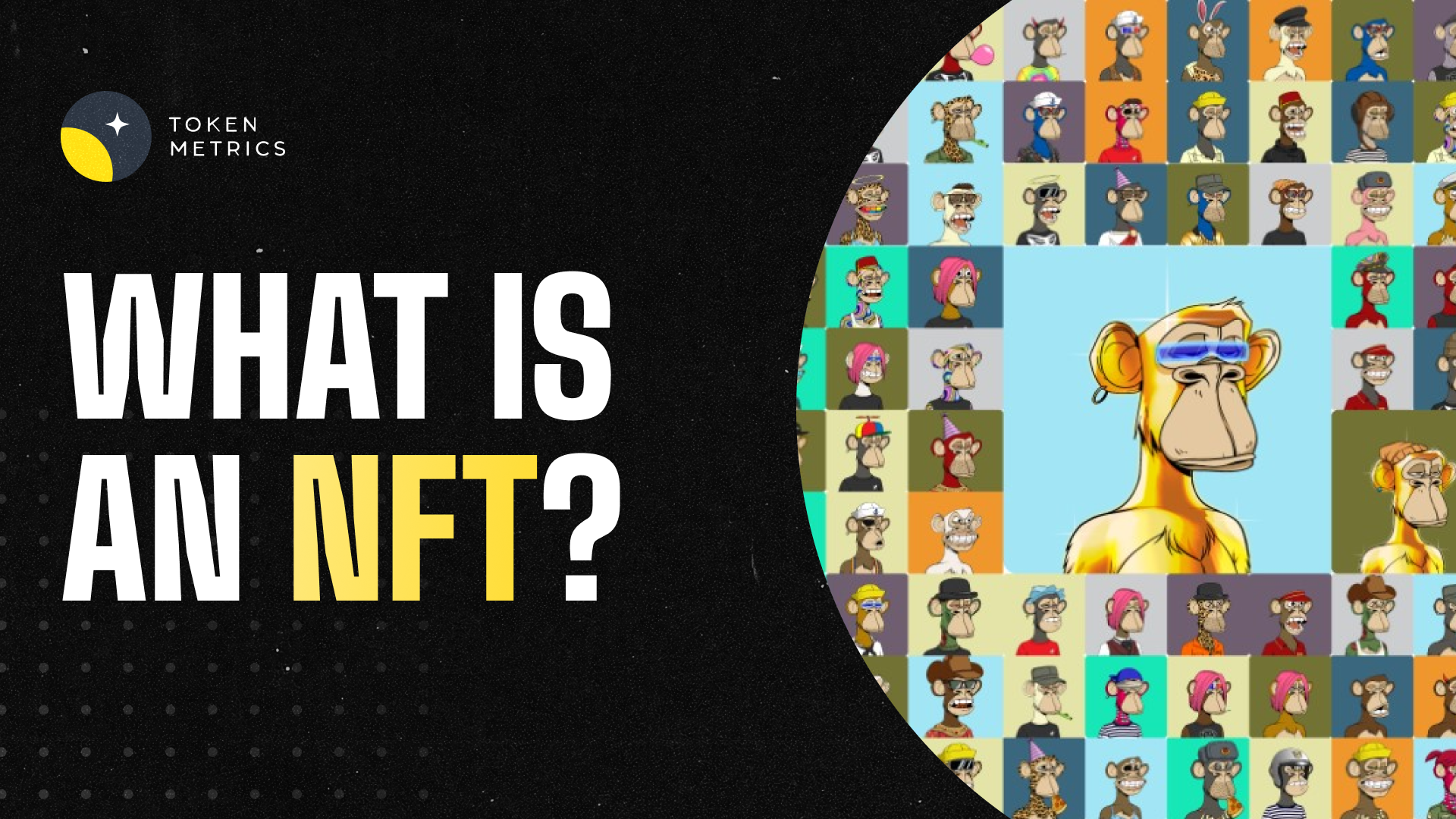
%201.svg)
%201.svg)
Over the past few years, NFTs (Non-Fungible Tokens) have exploded in popularity—revolutionizing the way we think about digital ownership, art, gaming, collectibles, and more. In 2025, NFTs continue to shape the future of the internet, transforming everything from music rights to virtual real estate.
If you're wondering “What is an NFT?” or how they actually work, this guide breaks it down for you. We’ll also explore how AI-powered tools like Token Metrics can help you identify high-value NFT-related tokens and investment opportunities.
NFT stands for Non-Fungible Token. Let’s break that down:
So, an NFT is a unique digital asset stored on a blockchain, representing ownership of a specific item—like artwork, music, a tweet, a game character, or a piece of virtual land.
NFTs aren’t just limited to pixelated apes or JPEGs. In 2025, NFTs power a broad range of digital assets:
Each NFT has a unique identifier and metadata that distinguish it from any other asset.
NFTs are built and recorded on blockchains, most commonly on Ethereum using ERC-721 or ERC-1155 standards. Here’s how they work:
Because of blockchain immutability, ownership is transparent, verifiable, and permanent.
Several reasons explain the rising value and popularity of NFTs:
In 2025, NFTs have gone beyond hype to form the foundation of Web3 identity and ownership.
To buy an NFT, you’ll need:

Once purchased, the NFT is transferred to your wallet and viewable on your profile.
NFTs are secure if you follow best practices. However, scams and phishing attacks are common.
Security Tips:
NFTs are not just collectibles—they’re tied to blockchain ecosystems and tokens. Platforms like Token Metrics help you identify high-potential NFT projects, gaming ecosystems, and utility tokens powering the space.
Whether it’s $IMX, $MAGIC, $APE, or a metaverse play like $MANA, Token Metrics gives you a data-driven edge.
NFTs are no longer limited to Ethereum. In 2025, several chains offer faster, cheaper minting and trading:
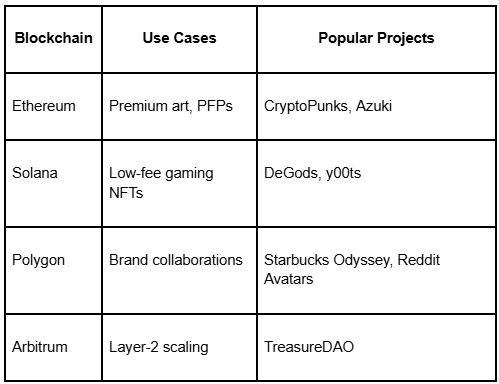
Token Metrics tracks all these chains, offering a cross-chain perspective for NFT investing.
Many NFT ecosystems have their own fungible tokens used for governance, staking, or ecosystem rewards. Examples include:
These tokens can rise in value based on NFT trading volume, user adoption, and staking incentives. Token Metrics’ analytics help traders spot breakout opportunities early.
NFTs are evolving fast. In 2025, they’re used for more than art and gaming:
Expect continued innovation, and stay ahead using tools like Token Metrics.
NFTs are more than a trend — they represent the digitization of ownership in the Web3 era. From art and identity to games and finance, NFTs unlock new possibilities for creators and collectors alike.
If you're looking to explore NFT opportunities beyond collectibles—Token Metrics gives you the data, AI tools, and insights you need to invest intelligently.
.png)
%201.svg)
%201.svg)
As the popularity of cryptocurrencies continues to grow in 2025, more people are seeking safe and secure ways to manage their digital assets. The first step in your crypto journey? Creating a crypto wallet.
In this guide, we’ll explain:
A crypto wallet is a digital tool that allows you to store, receive, and send cryptocurrencies like Bitcoin, Ethereum, and thousands of altcoins. Instead of holding physical money, it stores your private and public keys, giving you access to your blockchain assets.
Whether you're buying Bitcoin for the first time or diving into DeFi tokens, you'll need a crypto wallet to safely store and manage your coins.

Hot wallets are easier to set up and use, while cold wallets offer greater protection against hacks and malware.
Step 1: Download the App or Browser Extension
Step 2: Create a New Wallet
Step 3: Backup Your Recovery Phrase
Step 4: Confirm Your Recovery Phrase
Step 5: Wallet is Ready
✅ Pro Tip: Connect your wallet to Token Metrics to explore trading signals, moonshots, and AI analytics directly.
Step 1: Buy a Ledger or Trezor device
Step 2: Install Wallet Software
Step 3: Set Up Device and PIN
Step 4: Write Down Your Recovery Phrase
Step 5: Start Receiving Crypto
✅ Pro Tip: Use your cold wallet to store moonshots and long-term assets, then analyze performance using Token Metrics Portfolio tools.
While Token Metrics doesn't create wallets, it integrates seamlessly with your Web3 wallets to help you maximize profits and minimize risks.
Once your wallet is set up, use Token Metrics to find top-rated tokens across risk levels, market caps, and sectors.

Explore early-stage tokens with massive upside using the Moonshots tab—only available to Premium members.

Set up alerts for price, investor grade, or bullish/bearish signals—and receive them directly to your connected wallet’s contact info.

Monitor wallet performance across tokens with a real-time dashboard powered by on-chain data.
Different wallets support different blockchains, so always check compatibility before sending assets.

Q: Is creating a crypto wallet free?
Yes, most wallet apps like MetaMask or Trust Wallet are free.
Q: Can I create multiple wallets?
Absolutely. Many investors use different wallets for different purposes (e.g., trading, staking, savings).
Q: What happens if I lose my recovery phrase?
You lose access to your wallet permanently. Always store it securely.
Q: Do I need a wallet to use Token Metrics?
No, but connecting a wallet enhances your experience by allowing you to monitor portfolios, moonshots, and alerts in real time.

Creating a crypto wallet is your gateway to the decentralized world of digital finance. Whether you’re a seasoned trader or a beginner buying your first token, having a secure wallet is non-negotiable.
By choosing the right wallet (hot or cold), securing your keys, and combining it with powerful tools like Token Metrics, you can build a smart, secure, and profitable crypto journey.
%201%20(1).png)
%201.svg)
%201.svg)
Cryptocurrency offers unmatched freedom, but with that freedom comes responsibility—especially when it comes to how to store cryptocurrency securely. Unlike traditional banking, crypto is self-custodied. If you lose access to your wallet, your funds are gone forever.
This guide explains everything you need to know about storing crypto in 2025, including:
When you buy crypto—whether it’s Bitcoin, Ethereum, or a promising moonshot altcoin—you receive private keys that give you access to your funds. Anyone with that key can spend your coins.
That’s why safe storage is critical. Without it, your assets are vulnerable to:
You are your own bank, and your security strategy is your vault.
A crypto wallet is a digital tool that stores your private and public keys. It lets you send, receive, and manage your crypto.
There are two main types:
Let’s explore both.
Hot wallets are always online, making them easy to use for trading, DeFi, or daily transactions.
Cold wallets are offline storage solutions, ideal for long-term investors or large holdings.
Managed by exchanges (e.g., Binance, Coinbase). You don’t own the private keys.
Pros:
Cons:
You own the keys. Wallets like MetaMask, Trust Wallet, or hardware devices.
Pros:
Cons:
Tip: Token Metrics recommends non-custodial wallets for storing long-term holdings and moonshot tokens.
Token Metrics is an AI-powered crypto research and trading platform trusted by thousands of investors. While it doesn’t store your crypto directly, it helps you manage risk and store assets wisely by:

Token Metrics gives you AI-generated grades for tokens—helping you avoid scams and invest in credible projects worth storing long-term.
You can explore tokens, assess moonshots, and initiate trades directly from your connected Web3 wallet without leaving the platform.

Token Metrics allows you to track wallets and portfolio performance without requiring access to your private keys.

Through webinars, blog content, and investor resources, Token Metrics educates users on how to safely store their crypto in hot and cold wallets.
Your long-term Bitcoin, Ethereum, and moonshot tokens should live on a hardware wallet, not on an exchange.
Do NOT keep your recovery phrase in Google Docs or your phone. Use metal seed phrase storage or write it down and lock it in a safe.
Diversify storage:
Phishing is the #1 crypto threat. Double-check URLs, don’t sign unknown transactions, and avoid shady browser extensions.
Use platforms like Token Metrics Alerts or Etherscan to track your wallet and get notified of suspicious activity.

Storing cryptocurrency securely is just as important as choosing the right tokens to invest in. Whether you’re a day trader, long-term investor, or moonshot hunter, knowing when and where to store your crypto is key to protecting your wealth.
In 2025, the best strategy combines:
When you store your crypto properly, you don’t just protect your assets—you gain peace of mind.
.png)
%201.svg)
%201.svg)
In today’s fast-paced crypto world, real-time data isn’t a luxury—it’s a necessity. For traders, analysts, and developers, being able to access live, actionable insights can mean the difference between profit and loss. That’s why the integration of the Token Metrics Crypto Data API with Dune is a game-changer for anyone seeking to create live dashboards backed by intelligent trading data.
In this post, we’ll walk through how to use this top crypto API to build dynamic dashboards on Dune. Whether you’re tracking bullish signals, backtesting trading strategies, or identifying top-performing tokens, this integration makes it possible—without any paid license.
Let’s dive into how you can use the best free crypto API available today to transform your trading.
The Token Metrics Crypto Data API is a developer-focused gateway to powerful, AI-driven crypto data. It’s one of the top crypto APIs in 2025, giving you access to:
This API is used by both professional quant traders and beginners seeking to automate insights. And the best part? Token Metrics provides free crypto API access to selected datasets, allowing you to create powerful dashboards without spending a dime.
Dune is a blockchain analytics platform that allows you to write SQL queries and create dashboards using on-chain and off-chain data. Now that Token Metrics datasets are available on Dune, you can combine the best of both worlds:
This integration unlocks a whole new level of transparency and utility for crypto analysts, portfolio managers, and DeFi enthusiasts.
To begin, create a free Dune account. Once logged in, navigate to the Token Metrics datasets. These are publicly accessible and updated regularly. You’ll find tables for:
Start a new SQL query and choose the dataset you want to explore. Here’s what you’ll find in the trading signals table:

Step-by-Step: Creating an Actionable Dashboard with Token Metrics Data
Write a SQL query to calculate the average return of trading vs. holding strategies. For example:

This gives you the alpha—how much better the Token Metrics strategy performs compared to just HODLing.
In one real example, the average signal return across all tokens was 1630%, while holding returned just 400%. That’s a 12X improvement powered by this top crypto API.
Now let’s list tokens with the highest average alpha:

Tokens like BTC, ETH, BNB, and even newer ones like Virtuals stand out due to exceptional alpha performance.
The trader grade is a proprietary score from Token Metrics that predicts how favorable a token is for short-term traders.
Use a scatter plot to correlate trader grades with average alpha:
This helps you visually determine which tokens score high and offer exceptional returns—an essential tool for making actionable trading decisions.
Want to know which tokens are bullish right now? Here’s a query to find the most recent tokens flagged as bullish:

For example, on July 4th, tokens like BNB, XRP, and BTC were among the most recent bullish signals—perfect for immediate trade setups.
Once you’ve run your queries:
Your final product will be a real-time dashboard powered by the best crypto API, delivering insights that you—and your team—can act on instantly.
Here’s why Token Metrics stands out among other APIs:
Most APIs deliver raw data. Token Metrics provides curated signals, generated from machine learning models trained on market cycles, indicators, and price action.
Access unique indicators like trader grade and investor grade, unavailable anywhere else.
Use the API to backtest strategies. In the example shown, the AI strategy outperformed the market by over 1000X for some tokens.
Whether you're using Dune, Zapier, OpenAI, or Eliza OS, Token Metrics is easy to integrate and query—making it the top crypto API for developers and analysts alike.
The combination of Token Metrics’ intelligent data and Dune’s visualization tools puts immense power in your hands. Whether you’re tracking market trends, building bots, or guiding portfolio decisions, this integration gives you everything you need to trade smarter.
With free access to real-time trading signals, alpha comparisons, and powerful visualizations, Token Metrics proves why it's the best crypto API for today’s data-driven investor.
Ready to try it out?
👉 Explore the Free Crypto API
👉 Start Building on Dune
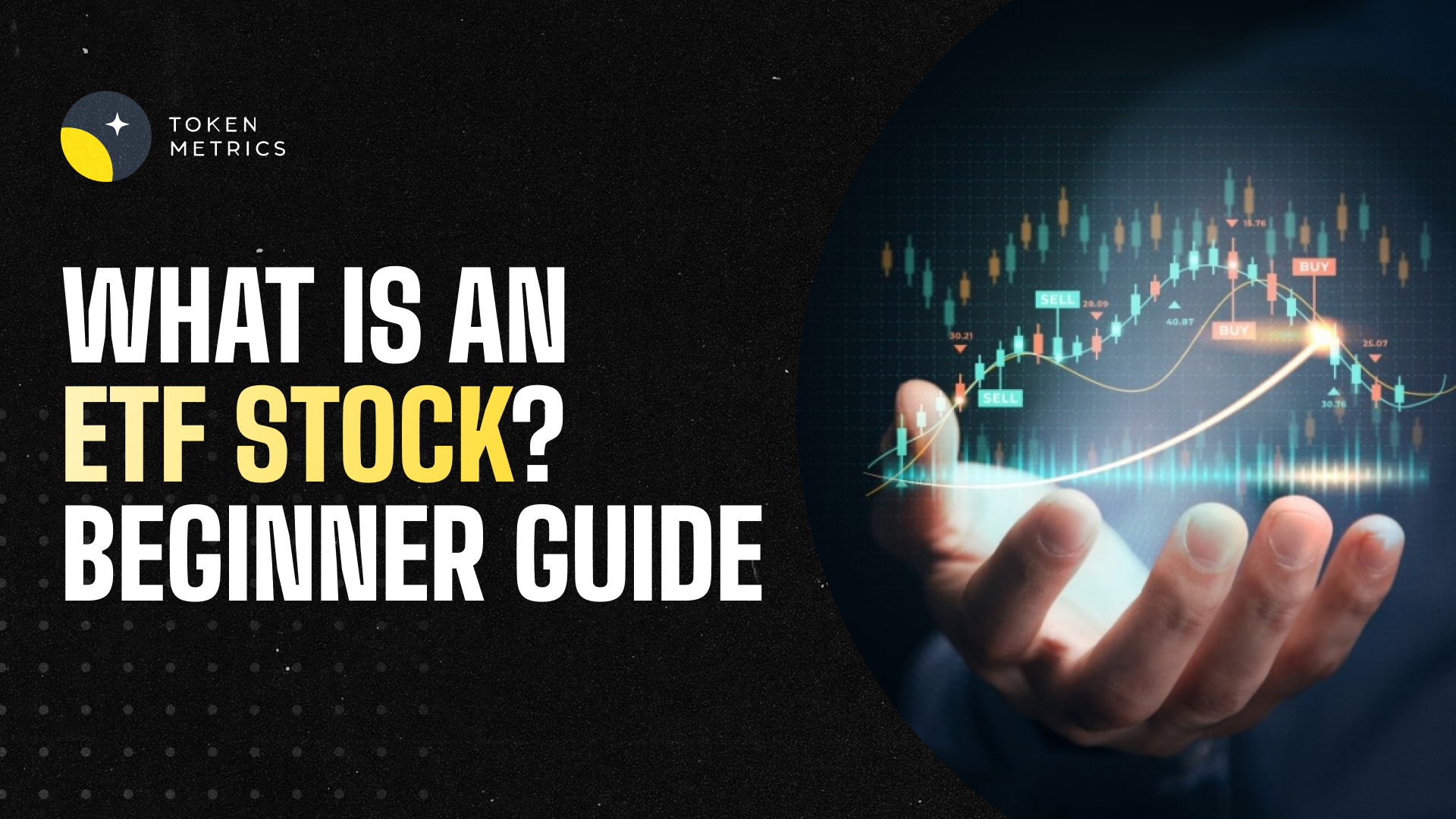
%201.svg)
%201.svg)
In today’s fast-moving financial markets, Exchange-Traded Funds, or ETF stocks, have emerged as one of the most popular investment vehicles for beginners and professionals alike. But what exactly is an ETF stock, how does it work, and why is it considered a smart way to invest?
This guide will walk you through everything you need to know about ETF stocks in 2025—including how they work, their benefits and risks, and how AI platforms like Token Metrics are changing the way people research and trade ETFs in both traditional and crypto markets.
An ETF stock refers to a share of an Exchange-Traded Fund—a type of investment fund that trades on stock exchanges, much like individual company stocks. Each ETF holds a basket of underlying assets such as:
When you buy an ETF stock, you’re buying a fractional share of the entire portfolio of assets held by that ETF.
ETF stocks work like this:
This model provides a liquid, transparent, and low-cost way for investors to gain diversified exposure to entire markets or sectors.
A good example is the SPDR S&P 500 ETF Trust (SPY), which tracks the performance of the S&P 500 index. When you buy a share of SPY, you gain exposure to 500 of the largest U.S. companies—without needing to buy each stock individually.
ETF stocks offer numerous advantages for investors in 2025:
Instead of buying individual assets, ETF stocks offer instant diversification by holding dozens or hundreds of securities in a single share.
ETFs are traded on exchanges, making them highly liquid. You can buy or sell them at market prices during normal trading hours.
ETFs typically have low expense ratios (as low as 0.03%), especially compared to mutual funds or actively managed portfolios.
Most ETFs disclose their holdings daily, giving investors a clear view into what they’re buying.
You can use ETFs for long-term investing, short-term trading, hedging, or generating income through dividends.
Despite their many benefits, ETF stocks do come with some risks:
ETF stocks are still subject to market volatility. If the underlying assets decline in value, so will the ETF.
Some ETFs may not perfectly replicate the performance of their index due to fees, slippage, or illiquid assets.
Because ETFs make it easy to invest, some investors may unknowingly become overexposed to a particular sector or strategy.
Not all ETFs are created equal. Low-volume ETFs may have wider bid-ask spreads, increasing trading costs.
In 2025, crypto ETF stocks have become a hot trend. These funds allow investors to gain exposure to digital assets without managing private keys, wallets, or blockchain protocols.
Types of crypto ETFs include:
Popular examples in 2025 include:
Crypto ETFs have opened the door for institutional and traditional investors to gain exposure to the crypto market in a regulated and simplified manner.
Whether you're interested in traditional ETF stocks or crypto ETFs, Token Metrics provides the AI-powered insights you need to make better investment decisions.
Token Metrics assigns each token or ETF a Trader Grade and Investor Grade based on price trends, volume, volatility, and technical strength—making it easy to spot outperformers.

AI-driven signals show when it’s time to buy or sell based on real-time metrics like ETF inflows, exchange balances, and market sentiment.

Get access to predictive models that estimate where Bitcoin, Ethereum, and major crypto ETFs are headed—based on 80+ factors.

Set custom alerts for ETF stock signals, price movements, or grade changes so you never miss an opportunity.

By combining ETF investing with Token Metrics’ AI analytics, you gain an informational edge in markets that move faster than ever.
Here’s a list of top-performing ETF stocks across traditional and crypto sectors:
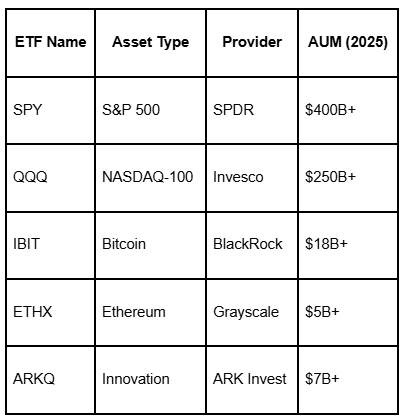
ETF stocks are a powerful investment tool in 2025, offering instant diversification, low fees, and easy access to traditional and crypto markets. Whether you're looking to build a retirement portfolio or ride the next Bitcoin rally, ETF stocks make it easier than ever to invest with confidence.
And with platforms like Token Metrics, you don’t need to guess your way through ETF trading. Use AI-driven insights, price predictions, and real-time data to get ahead of the curve—no matter what markets you trade.
.png)
%201.svg)
%201.svg)
The world of crypto investing is expanding at lightning speed. With growing institutional adoption and mainstream interest, new financial instruments are emerging to make crypto more accessible to everyday investors. One of the most impactful of these tools is the Exchange-Traded Fund (ETF) — and in 2025, crypto ETFs are playing a crucial role in shaping the future of digital asset investing.
An ETF (Exchange-Traded Fund) is a type of investment fund traded on traditional stock exchanges, just like individual stocks. ETFs hold a basket of assets such as stocks, bonds, commodities—or, in this case, cryptocurrencies.
When you buy shares of an ETF, you’re investing in a diversified portfolio managed by an institution. Instead of buying each asset individually, ETFs let you gain exposure to a group of assets through a single security.
A crypto ETF is a special type of ETF that tracks the price of one or more cryptocurrencies, such as Bitcoin, Ethereum, or a basket of altcoins. These ETFs allow investors to gain exposure to crypto markets without needing to buy, store, or manage digital assets directly.
Crypto ETFs are listed on traditional financial exchanges (like Nasdaq or NYSE) and can be purchased via brokerage accounts—making them ideal for both institutional investors and crypto-curious retail traders.
There are two main categories of crypto ETFs:
In 2025, spot ETFs have become more popular, especially after multiple approvals in major markets like the U.S., Canada, and Hong Kong.
Crypto ETFs offer a range of advantages for investors seeking exposure to digital assets without managing crypto wallets or private keys.
While crypto ETFs simplify access, they are not risk-free.
The launch and adoption of crypto ETFs signal mainstream validation of the crypto market.
Crypto ETFs reduce barriers to entry and give traditional investors a safe, regulated way to participate in the digital economy.
As ETFs drive price action, tools like Token Metrics give you an edge by turning market noise into actionable intelligence.
Token Metrics' AI algorithm scans exchange inflows, ETF data, and sentiment to issue buy/sell signals for major cryptocurrencies like Bitcoin, Ethereum, XRP, and more.

Track ETF fund flows to understand where institutions are allocating capital—key for timing your own entries and exits.
AI-generated price predictions, trader grades, and investor scores help you assess risk before investing in ETF-driven rallies.

Token Metrics syncs with your wallet or brokerage to track crypto ETF exposure alongside your on-chain tokens.
By using Token Metrics, you’re not just following ETF trends—you’re staying ahead of them.
Here are some of the top-performing crypto ETFs currently available:
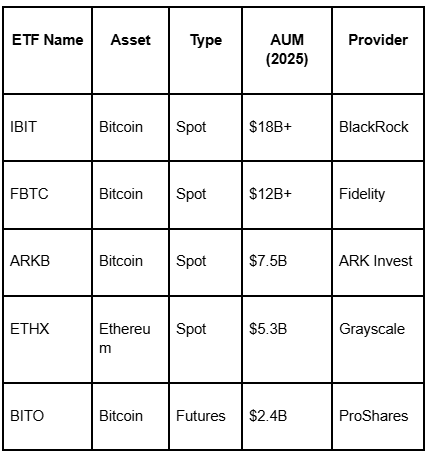
These ETFs are helping investors tap into the gains of crypto markets—without the complexity.
Crypto ETFs represent a pivotal shift in how digital assets are being embraced in traditional finance. They offer accessibility, regulatory clarity, and simplified crypto exposure for everyone from hedge funds to retail investors.
But smart investing goes beyond headlines. Platforms like Token Metrics help you:
In 2025 and beyond, the winning strategy is clear: combine the safety of ETFs with the intelligence of Token Metrics.


 Create Your Free Account
Create Your Free Account9450 SW Gemini Dr
PMB 59348
Beaverton, Oregon 97008-7105 US
.svg)




.png)
Token Metrics Media LLC is a regular publication of information, analysis, and commentary focused especially on blockchain technology and business, cryptocurrency, blockchain-based tokens, market trends, and trading strategies.
Token Metrics Media LLC does not provide individually tailored investment advice and does not take a subscriber’s or anyone’s personal circumstances into consideration when discussing investments; nor is Token Metrics Advisers LLC registered as an investment adviser or broker-dealer in any jurisdiction.
Information contained herein is not an offer or solicitation to buy, hold, or sell any security. The Token Metrics team has advised and invested in many blockchain companies. A complete list of their advisory roles and current holdings can be viewed here: https://tokenmetrics.com/disclosures.html/
Token Metrics Media LLC relies on information from various sources believed to be reliable, including clients and third parties, but cannot guarantee the accuracy and completeness of that information. Additionally, Token Metrics Media LLC does not provide tax advice, and investors are encouraged to consult with their personal tax advisors.
All investing involves risk, including the possible loss of money you invest, and past performance does not guarantee future performance. Ratings and price predictions are provided for informational and illustrative purposes, and may not reflect actual future performance.



